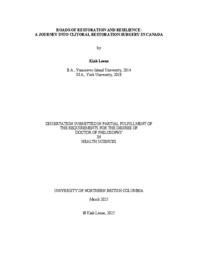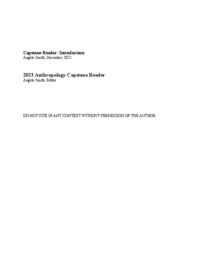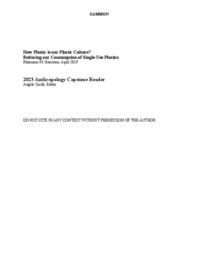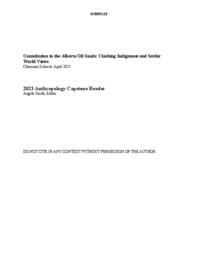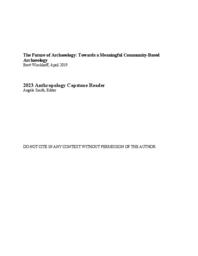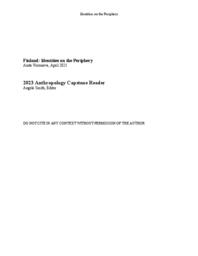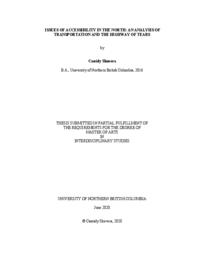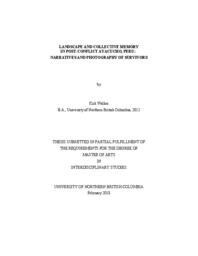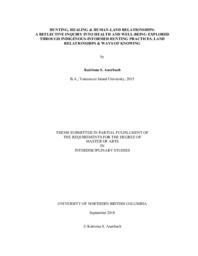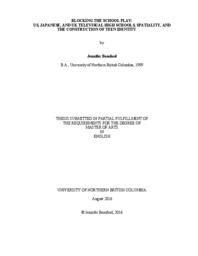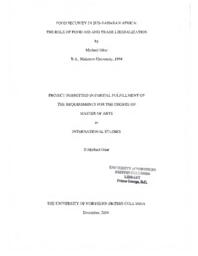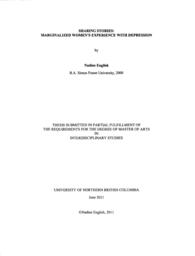Smith, Angèle
Person Preferred Name
Angèle Smith
Affiliation
Related Works
Content type
Digital Document
Origin Information
Content type
Digital Document
Origin Information
Content type
Digital Document
Origin Information
Content type
Collection
Description / Synopsis
The 2023 edition of research completed in UNBC's ANTH 460 Capstone course.
Origin Information
Content type
Digital Document
Description / Synopsis
Provides an editorial introduction to the 2023 UNBC Anthropology Capstone Reader.
Origin Information
Content type
Digital Document
Description / Synopsis
The ongoing global refugee crisis has been, and continues to be, one of the most pressing humanitarian issues facing the world today. The global trends of destabilization, conflict, and persecution that have been fueling this crisis show no signs of stopping. Clearly, the issues that must be considered are too numerous to cover exhaustively in a single paper. Refugee and migration studies is a vast and complex topic with many specializations and subfields. Thus, for the sake of feasibility and actually generating meaningful information, it seems necessary to focus specifically on both a category of asylum seekers and a country to which they are applying. By doing so, the goal of this paper will be to participate in a more nuanced, and therefore more personal, exploration of a specific set of issues within a specific refugee intake apparatus that may then potentially be used to explore how current immigration systems may be improved. Therefore, this paper shall focus specifically on the experience of SOGI (Sexual Orientation and Gender Identity) asylum seekers, perhaps more commonly known outside of legal documents as LGBTQ+, as they navigate the Canadian refugee intake apparatus.
Origin Information
Content type
Digital Document
Description / Synopsis
Our deep attachment to plastics exists within a complex set of relationships between manufacturers, consumers, markets, and environmental forces. In this paper, I question the reasons behind these relationships and seek to discover why we have become so attached to plastics, and why it is so hard to break this attachment. The effects of plastics extend far beyond the issue of litter, but relate to our construction of identity and our sense of social justice. In this paper, I will argue that plastic is reflective of who we are, and also reflective of the global inequalities we have created and is thus an important social justice issue. I will employ the theory of political ecology to analyze the consumption of single-use plastics within industrialized countries and to untangle these complex relationships. This theory will highlight the influence of finance and power and help to unravel the role of industry and institutions in the seemingly agential decisions we make as consumers. I will then discuss why the plastics problem is so pressing, and why we need to change our culture of single-use plastics. The issue of single-use plastics has widespread global effects, and thus solving the plastics problem is a matter of social justice. I will then apply a political ecological framework to argue that single-use plastics are an integral part of consumer culture, and lie at the core of our identity as a society. Finally, I will turn to the question of how and if our plastic culture is capable of changing.
Origin Information
Content type
Digital Document
Description / Synopsis
Indigenous calls for sovereignty, recognition of ancestral claims, and territorial rights are topics that are becoming increasingly relevant in Canada, particularly as industry continues to put pressure on provincial and federal governments to develop on Indigenous people’s traditional territory. Through the aggressive push for development and extraction of natural resources, two very different ontological perspectives1 of the land are coming into contact, often with the result that projects are delayed and/or brought to the courts, as well as arguably sabotaging efforts of collaboration and reconciliation in other areas of social and political life (Boyd and Lorefice 2018:573). Indeed, the settler-colonial ontological perspective of the land that believes that “any natural resource not used [is] wasted” (Davis 2018:145) conflicts with many First Nations’ traditional systems of stewardship and sustainability (Turner and Jones 2000). As such, a critical space that is worthy of examination is the consultation process because the duty to consult is legally mandated and is one of the few spaces in which the two “ways of knowing” the land come into contact. Accordingly, the research questions which guided my analysis include an examination of how the different ontological perspectives come into conflict when they make contact within the consultation process and what is required for meaningful consultations to take place that accommodate both ontological perspectives. Finding a way to identify and provide solutions to issues of land is of particular importance to contemporary society, as both Indigenous and settler-colonial people draw important connections between the land and their distinct identity and heritage, and neither are going to cede quietly to the other. Further, the need for cooperation is vital in a world where issues of land will become increasingly relevant because of climate change and scarcity of natural resources. In this way anthropology is demonstrably contributing to social issues in society, as the discipline that cultivates the ability to accommodate for, and critically examine, numerous and conflicting worldviews.
Origin Information
Content type
Digital Document
Description / Synopsis
Archaeology and archaeological theory are currently largely in the era of post-processualism. This has been significant as it has changed the ways that archaeologists interact with communities who are stakeholders in community-based archaeological research. However, not all archaeological research has followed suit and in many countries the archaeology still practiced does not include or benefit the local communities. I argue that moving into the future, archaeology must adopt a community-based approach as a mandatory practice in all situations. Community-based archaeology is relatively new in many parts of the world and thus its meaning is still ambiguous. How can we, as archaeologists, do better for the communities we work with and create long-lasting meaningful relationships with them? Community-based archaeology can mean many things and its breadth is part of what makes it so useful, but I argue that it must include meaningful engagement with the source community which leads to a form of heritage-building and empowerment.
Origin Information
Content type
Digital Document
Description / Synopsis
The troubled histories of nations are built from the bones of a million damaged children. But what about the nations and children who are stuck in the periphery between troubled and happy, between damaged and healthy? These are the settings that anthropology can thrive in: nations that have both suffered and benefited from colonialism, oppressed groups discriminating against others, and other ambiguous cultural dynamics. In this paper, I want to focus on Finland as a specific nation that serves as a good example of how collective trauma and ambiguous histories can be contested. These contestations are most commonly expressed through minute inequalities between the two main cultural groups in Finland: Finnish and Swedish-speaking Finns. Modern inequalities between different cultural and linguistic groups in and around Finland are expressed through stereotypes and expressions of identity. These stereotypes and identities are often mixed with ambivalent feelings, especially in regard to Finns' relationship with Sweden: the state and people, both historically and in the present. These relationships are based on the hegemonic and non-hegemonic views that Finnish speakers, Fennoswedes, and Swedes hold of each other. Hegemonically, quiet admiration and casual disapproval are common, hence the ambiguity. Non-hegemonically, extreme emotions and fixations are commonly perceived as strange and distasteful; everything must be just right, or lagom in Swedish. In this paper, I focus the discussion on Finnish issues of cultural and linguistic identity while keeping their relationship with the Swedish state and people in mind. Hence, my goal is to answer these questions: How has discrimination shaped Finnish identities? Has it shaped Finnish-speaking versus Swedish-speaking Finnish identities differently? How does a collective memory of oppression affect Finnish peoples' perceptions of others? However, what I ultimately want to answer is what is the source of Finland’s ambiguous historical identity: were Finns victims of ethnic discrimination or is this a narrative produced by historical revisionism?
Origin Information
Content type
Digital Document
Description / Synopsis
Vaccine-hesitancy and vaccine rejection are huge problems facing global public health today. Diseases which were once considered to be virtually eliminated due to widespread vaccination are returning with a vengeance, as cases of measles, mumps and chickenpox pop up and spread throughout Europe and North America. As herd immunity diminishes, deadly infectious diseases spread more easily among vulnerable human hosts. This is all due to the growing trend of purposefully forgoing routine vaccinations. Anti-vaccine communities have been steadily growing online for years, and now wield a potent influence on social media. Widespread access to social media increases the ease with which misinformation about vaccines can spread and reach new audiences across the globe. In this paper, I will be seeking to answer the question: what is the anti-vaccine movement and how does this movement interact with social media? I will also examine what role identity plays in attracting new believers to the anti-vaccine community, if any.
Origin Information
Content type
Collection
Description / Synopsis
Highlights research completed in UNBC's ANTH 460 Capstone course.
Content type
Digital Document
Description / Synopsis
The thesis investigated how conflicting gender ideologies influenced Nigerian-immigrant women's experiences of domestic violence in Canada. Nigeria, the participants' country of heritage, practices patriarchal social stratification while Canada, the country of current residence, has egalitarian structures. Using a qualitative research orientation and non-probability purposive snowballing sampling procedures with ten (10) Nigerian immigrant women to Canada, data collection procedures involved electronic phone interviews. The data analysis process involved transcription, categorization, coding, and theme generation by the researcher. The nine major themes identified that the study participants experiences a change or shift in gender ideologies towards more egalitarian ideologies while some of their partners did not experience the same change, thereby resulting in conflicting gender ideologies that influenced their experiences of domestic violence. The thesis concluded with recommendations for culturally sensitive services that combat domestic violence, and ease adjustment into Canadian communities for the study participants and immigrant women in general.
Origin Information
Content type
Digital Document
Description / Synopsis
The Highway of Tears is a term that is known across northern British Columbia. Since 1969, women and girls have gone missing and been found murdered along the 724 km stretch of Highway 16 between Prince Rupert and Prince George, British Columba. Many of these women were trying to get from one destination to another when their safety was compromised. These individuals were from communities with few transportation options available and where hitchhiking is a common form of transportation. Using an interdisciplinary perspective including northern studies, political science, and women’s studies I will analyze the issues of transportation in the north in connection to the Highway of Tears case. In particular I will examine how the Highway 16 Transportation Action Plan developed in order to determine what happened and why it took ten years for a policy response to emerge that addressed safety concerns and transportation gaps in the north.
Origin Information
Content type
Digital Document
Description / Synopsis
This research explores the experiences of women participating in CDOs (community development organizations) in communities in northern British Columbia and how that participation affects their capabilities. Data was gathered through interviews, electronic surveys, and participant observation. This data was then assessed within the combined theoretical frameworks of the capabilities approach and participatory development. Through analysis, the positive impacts of women’s participation in CDOs on their capabilities and communities were brought to light.
Origin Information
Content type
Digital Document
Description / Synopsis
Over the last decade, the number of Honduran migrant children traveling undocumented to the United States and Mexico increased substantially and both countries have focused on the detention and return of these children. While several organizations in Honduras assist returned children, these efforts have been insufficient as returned children migrate again and more children are migrating for the first time. This thesis aims to examine organizations’ challenges in promoting returned children’s human rights during their reintegration. Through a qualitative research design, data were collected from the literature, institutional documents and interviews with representatives from organizations in the government and non-government sectors. Results reflect challenges to implement the human rights approach and some principles such as non-refoulement, the right to life, survival and development and the best interest of the child. Also, practical challenges were found including the lack of inter-institutional coordination, financial and human resources, and monitoring mechanisms.
Origin Information
Content type
Digital Document
Description / Synopsis
This thesis examines three Gothic novels: The Romance of the Forest and The Mysteries of Udolpho by Ann Radcliffe and Northanger Abbey by Jane Austen. In these three novels, the female heroines of each struggle against the patriarchal power structures of eighteenth-century society. Immersion in a natural environment strengthens these female Gothic heroines, aiding them to resist the will of male characters and to establish agency. Gothic nature is an ally to women, while Gothic urban settings act as a domain of oppression for both women and nature. The authors Ann Radcliffe and Jane Austen wrote active heroines who in turn influenced female readers. These novels and their heroines were an active influence on feminist thought and ideas in eighteenth century England.
Origin Information
Content type
Digital Document
Origin Information
Content type
Digital Document
Origin Information
Content type
Digital Document
Origin Information
Content type
Digital Document
Origin Information
Content type
Digital Document
Origin Information
Content type
Digital Document
Origin Information
Content type
Digital Document
Origin Information
Content type
Digital Document
Origin Information



